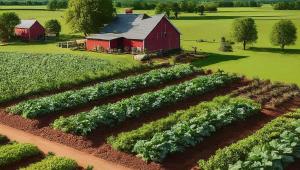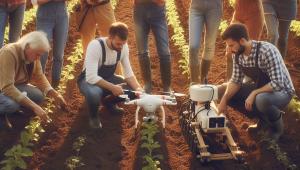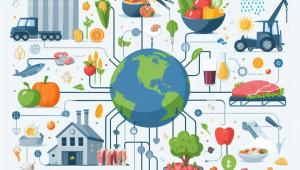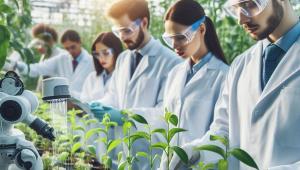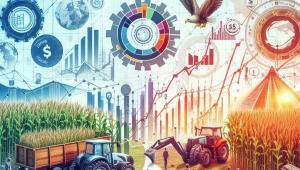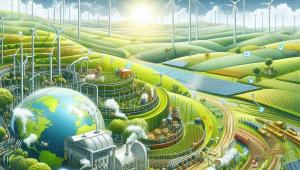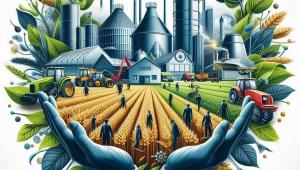Farm management is the process of overseeing and coordinating various aspects of a farm to ensure its smooth operation, profitability, and long-term sustainability. Effective farm management involves a wide range of skills and knowledge, including crop and livestock production, financial planning, marketing, risk management, and human resource management. In this comprehensive guide, we will explore the key principles and practices of farm management, as well as the various services, vendors, and technologies that can support farmers in their efforts to optimize their operations.
Farm Planning and Budgeting
One of the most critical aspects of farm management is planning and budgeting. This involves setting clear goals and objectives for the farm, developing a detailed business plan, and creating a budget that accounts for all anticipated income and expenses.
Goal Setting and Business Planning
The first step in farm planning is to establish clear, measurable goals for the farm. These goals should be based on a thorough assessment of the farm's resources, including land, labor, capital, and market opportunities. Some common goals for farms include:
- Increasing production and yield
- Improving product quality and consistency
- Reducing costs and increasing efficiency
- Diversifying crops or livestock
- Expanding into new markets
Once goals have been established, the next step is to develop a detailed business plan that outlines the strategies and actions needed to achieve those goals. A well-crafted business plan should include:
- A description of the farm's products and services
- An analysis of the target market and competition
- A marketing and sales strategy
- A production plan, including crop or livestock management practices
- A financial plan, including projected income, expenses, and cash flow
- A risk management plan, identifying potential risks and strategies for mitigating them
Budgeting and Financial Management
Effective financial management is essential for the long-term success and sustainability of any farm. This involves creating a detailed budget that accounts for all anticipated income and expenses, as well as regularly monitoring and adjusting the budget based on actual performance.
Some key components of a farm budget include:
- Projected income from crop or livestock sales
- Operating expenses, such as seed, feed, fertilizer, and fuel
- Labor costs, including wages and benefits
- Capital expenses, such as equipment purchases or building improvements
- Overhead expenses, such as insurance, taxes, and utilities
In addition to budgeting, farmers must also keep accurate financial records and use this information to make informed decisions about production, marketing, and investment. This may involve working with an accountant or financial advisor who specializes in agricultural businesses.
Crop and Livestock Management
At the heart of any farm operation is the production of crops and/or livestock. Effective crop and livestock management involves a wide range of practices and technologies designed to optimize yield, quality, and profitability while minimizing environmental impact and ensuring animal welfare.
Crop Management Practices
Crop management practices vary widely depending on the type of crop, the local climate and soil conditions, and the farmer's goals and resources. However, some common crop management practices include:
- Soil management: Maintaining soil health and fertility through practices such as crop rotation, cover cropping, and nutrient management.
- Planting and seeding: Selecting appropriate crop varieties, planting at the optimal time and density, and using precision planting technologies where appropriate.
- Irrigation and water management: Ensuring that crops receive the right amount of water at the right time through efficient irrigation systems and water conservation practices.
- Pest and disease management: Monitoring crops for signs of pest or disease pressure and using a combination of cultural, biological, and chemical control methods to minimize damage.
- Harvest and post-harvest handling: Timing harvest to optimize quality and yield, and properly storing and handling crops to maintain quality and minimize losses.
Livestock Management Practices
Like crop management, livestock management practices vary depending on the type of animal, the production system, and the farmer's goals and values. However, some common principles of livestock management include:
- Animal health and welfare: Providing animals with a safe, comfortable environment, appropriate nutrition and veterinary care, and opportunities to express natural behaviors.
- Breeding and reproduction: Selecting appropriate breeding stock, managing breeding programs to improve genetic quality and productivity, and ensuring the health and welfare of breeding animals and their offspring.
- Nutrition and feeding: Providing animals with a balanced diet that meets their nutritional needs at different stages of growth and production, while minimizing feed costs and environmental impact.
- Housing and facilities: Designing and maintaining housing and facilities that provide animals with a safe, comfortable environment and allow for efficient management and handling.
- Product quality and safety: Ensuring that animal products, such as milk, eggs, or meat, are of high quality and safe for human consumption through appropriate management practices and quality control measures.
Precision Agriculture Technologies
In recent years, advances in precision agriculture technologies have revolutionized crop and livestock management, allowing farmers to optimize production and minimize inputs based on detailed, site-specific data. Some examples of precision agriculture technologies include:
- GPS and GIS mapping: Using global positioning systems (GPS) and geographic information systems (GIS) to create detailed maps of fields or pastures, allowing for precision planting, nutrient management, and other site-specific practices.
- Remote sensing: Using satellite imagery, drones, or other remote sensing technologies to monitor crop health, soil moisture, and other variables, allowing for early detection of problems and targeted management interventions.
- Precision application equipment: Using variable rate application equipment to apply seed, fertilizer, or other inputs at precise rates based on site-specific data, minimizing waste and optimizing productivity.
- Livestock monitoring: Using electronic identification, biosensors, or other technologies to monitor individual animal health, behavior, and productivity, allowing for early detection of problems and targeted management interventions.
Marketing and Sales
Effective marketing and sales are critical for the financial success of any farm operation. This involves identifying target markets, developing a marketing strategy, and building relationships with customers and sales channels.
Market Analysis and Strategy
The first step in developing a marketing strategy is to conduct a thorough analysis of the target market, including:
- Consumer demographics and preferences
- Competition from other farms or food businesses
- Market trends and growth potential
- Regulatory requirements and constraints
Based on this analysis, farmers can develop a marketing strategy that identifies the most promising market opportunities and outlines the actions needed to pursue those opportunities. This may involve:
- Differentiating products based on quality, sustainability, or other attributes
- Developing a strong brand identity and messaging
- Identifying the most effective marketing channels, such as farmers markets, CSA programs, or wholesale distributors
- Setting prices based on production costs, market demand, and competition
Direct Marketing and Sales
Many small and mid-sized farms rely on direct marketing and sales to connect with customers and capture a larger share of the value of their products. Some common direct marketing channels include:
- Farmers markets: Selling products directly to consumers at local farmers markets can be an effective way to build relationships with customers and capture a premium price for high-quality, locally grown products.
- Community Supported Agriculture (CSA): In a CSA program, customers pay upfront for a share of the farm's harvest, providing the farmer with a guaranteed market and a source of working capital.
- On-farm sales: Some farms offer on-farm sales, such as farm stands or U-pick operations, allowing customers to purchase products directly from the farm and experience the farming environment.
- E-commerce: Online sales platforms, such as farm websites or third-party marketplaces, can allow farms to reach a broader customer base and sell products directly to consumers.
Wholesale Marketing and Sales
For larger farms or those with a high volume of production, wholesale marketing and sales may be a more viable option. This involves selling products to intermediaries, such as food processors, distributors, or retailers, who then sell the products to end consumers.
Successful wholesale marketing and sales requires:
- Consistent quality and volume of production
- Competitive pricing based on market conditions and production costs
- Strong relationships with buyers and intermediaries
- Compliance with food safety and other regulatory requirements
Risk Management
Farming is an inherently risky business, with a wide range of potential risks that can impact production, profitability, and long-term sustainability. Effective risk management involves identifying potential risks, assessing their likelihood and potential impact, and developing strategies to mitigate or cope with those risks.
Production Risks
Production risks are those that impact the quantity or quality of crops or livestock produced. Some common production risks include:
- Weather and climate risks, such as drought, flooding, or extreme temperatures
- Pest and disease risks, which can reduce yields or quality
- Equipment and infrastructure risks, such as breakdowns or failures
- Human resource risks, such as labor shortages or accidents
Strategies for managing production risks may include:
- Diversifying crops or livestock to spread risk
- Investing in irrigation, drainage, or other infrastructure to mitigate weather risks
- Implementing integrated pest management or other strategies to minimize pest and disease risks
- Developing contingency plans and emergency preparedness to cope with unexpected events
Market Risks
Market risks are those that impact the prices or demand for farm products. Some common market risks include:
- Price volatility due to changes in supply and demand
- Competition from other farms or food businesses
- Changes in consumer preferences or market trends
- Trade disruptions or policy changes that impact market access
Strategies for managing market risks may include:
- Diversifying marketing channels to spread risk
- Using forward contracts, futures markets, or other price risk management tools
- Building strong relationships with buyers and customers to ensure consistent demand
- Staying informed about market trends and policy developments that may impact the farm business
Financial Risks
Financial risks are those that impact the farm's ability to generate sufficient income, manage debt, or maintain financial stability. Some common financial risks include:
- Production and market risks that impact revenue
- Rising input costs, such as feed, seed, or fuel
- Debt and interest rate risks
- Risks associated with investments or expansion
Strategies for managing financial risks may include:
- Developing and adhering to a realistic budget and financial plan
- Maintaining accurate financial records and using them to make informed decisions
- Diversifying income streams to reduce reliance on a single crop or market
- Working with a financial advisor or lender to manage debt and investment risks
Human Resource Management
Effective human resource management is critical for the success and sustainability of any farm operation. This involves attracting, developing, and retaining a skilled and motivated workforce, as well as ensuring compliance with labor laws and regulations.
Workforce Planning and Recruitment
Workforce planning involves assessing the farm's labor needs and developing strategies to meet those needs through recruitment, training, and retention. Some key considerations in workforce planning include:
- Identifying the skills and experience needed for different roles and tasks
- Assessing the availability and cost of labor in the local market
- Developing job descriptions and recruitment strategies to attract qualified candidates
- Ensuring compliance with labor laws and regulations related to wages, benefits, and working conditions
Employee Training and Development
Investing in employee training and development can help to improve productivity, quality, and job satisfaction, as well as reduce turnover and safety risks. Some strategies for employee training and development include:
- Providing on-the-job training and mentoring to new employees
- Offering continuing education and professional development opportunities
- Encouraging cross-training and skill development to increase flexibility and resilience
- Fostering a culture of learning and continuous improvement
Performance Management and Retention
Effective performance management and retention strategies can help to ensure that employees are motivated, productive, and committed to the farm's success. Some strategies for performance management and retention include:
- Setting clear performance expectations and providing regular feedback and coaching
- Recognizing and rewarding high performance through bonuses, promotions, or other incentives
- Providing competitive wages and benefits to attract and retain top talent
- Fostering a positive and supportive workplace culture that values employee well-being and work-life balance
Sustainability and Environmental Management
Sustainability and environmental management are increasingly important considerations for farm operations, both from an ethical perspective and as a means of reducing costs, mitigating risks, and meeting consumer and regulatory demands.
Soil Health and Conservation
Maintaining and improving soil health is critical for long-term productivity and sustainability. Some strategies for soil health and conservation include:
- Implementing conservation tillage or no-till practices to reduce soil erosion and improve soil structure
- Using cover crops and crop rotations to improve soil fertility and biodiversity
- Minimizing the use of synthetic fertilizers and pesticides that can degrade soil health
- Monitoring soil health through regular testing and assessment
Water Management and Conservation
Water is a critical resource for agriculture, and effective water management and conservation practices can help to reduce costs, improve crop yields, and minimize environmental impacts. Some strategies for water management and conservation include:
- Implementing efficient irrigation systems, such as drip irrigation or precision sprinklers
- Using soil moisture sensors and other technologies to optimize irrigation scheduling
- Adopting water-conserving crops and production practices, such as drought-tolerant varieties or conservation tillage
- Protecting and restoring riparian areas and other water resources on the farm
Energy Management and Renewable Energy
Energy is a significant cost for many farm operations, and adopting energy-efficient practices and renewable energy technologies can help to reduce costs and improve sustainability. Some strategies for energy management and renewable energy include:
- Conducting an energy audit to identify opportunities for efficiency improvements
- Investing in energy-efficient equipment and technologies, such as LED lighting or variable frequency drives
- Adopting renewable energy technologies, such as solar panels or wind turbines
- Implementing energy conservation practices, such as reducing tillage or optimizing fertilizer use
Waste Management and Recycling
Effective waste management and recycling practices can help to reduce costs, minimize environmental impacts, and improve the overall sustainability of the farm operation. Some strategies for waste management and recycling include:
- Developing a comprehensive waste management plan that identifies all waste streams and disposal options
- Implementing composting or other organic waste recycling practices
- Properly disposing of hazardous wastes, such as pesticides or oil
- Exploring opportunities for waste-to-energy or other value-added uses of waste materials
Technology and Innovation
Advances in technology and innovation are transforming the way that farms are managed and operated, from precision agriculture and robotics to data analytics and artificial intelligence.
Precision Agriculture Technologies
Precision agriculture technologies, such as GPS, GIS, and remote sensing, allow farmers to collect and analyze detailed data about their crops and fields, enabling more precise and efficient management practices. Some examples of precision agriculture technologies include:
- Yield monitors and maps that allow farmers to identify areas of high and low productivity
- Variable rate application technologies that adjust seed, fertilizer, or pesticide rates based on site-specific conditions
- Soil moisture sensors and weather stations that provide real-time data to inform irrigation and other management decisions
Robotics and Automation
Robotics and automation technologies are increasingly being used in agriculture to improve efficiency, reduce labor costs, and enhance precision and consistency. Some examples of robotics and automation technologies include:
- Autonomous tractors and other field equipment that can operate without human intervention
- Robotic milking systems that allow cows to be milked on demand without human labor
- Automated planting and harvesting systems that can work around the clock with high precision
Data Analytics and Artificial Intelligence
Data analytics and artificial intelligence technologies are helping farmers to make more informed and data-driven decisions about their operations. Some examples of data analytics and artificial intelligence technologies include:
- Predictive analytics tools that use historical data and machine learning algorithms to forecast crop yields, disease outbreaks, or other outcomes
- Decision support systems that provide real-time recommendations for irrigation, fertilization, or other management practices based on sensor data and analytics
- Computer vision and machine learning algorithms that can identify and diagnose crop stress or disease based on images or sensor data
Food Safety and Traceability
Ensuring food safety and traceability is a critical responsibility for farmers and food businesses, and requires a comprehensive approach that includes risk assessment, hazard control, and record-keeping.
Food Safety Risks and Hazards
Food safety risks and hazards can occur at any stage of the food supply chain, from production and processing to distribution and retail. Some common food safety risks and hazards include:
- Biological hazards, such as bacteria, viruses, or parasites that can cause foodborne illness
- Chemical hazards, such as pesticide residues, heavy metals, or other contaminants
- Physical hazards, such as metal fragments, glass, or other foreign objects
Food Safety Management Systems
Effective food safety management requires a systematic approach that includes hazard analysis, risk assessment, and preventive controls. Some common food safety management systems and practices include:
- Good Agricultural Practices (GAP) and Good Handling Practices (GHP) that outline best practices for producing and handling fresh produce
- Hazard Analysis and Critical Control Points (HACCP) systems that identify and control potential hazards at critical points in the food supply chain
- Traceability systems that enable the tracking and tracing of food products from farm to fork
Record-Keeping and Documentation
Accurate and complete record-keeping and documentation are essential for ensuring food safety and traceability, as well as for demonstrating compliance with regulatory requirements. Some key records and documents that farmers and food businesses should maintain include:
- Planting and harvesting records that document the source, variety, and quantity of crops produced
- Input records that document the use of fertilizers, pesticides, and other agricultural inputs
- Processing and handling records that document the steps involved in preparing and packaging food products
- Shipping and distribution records that document the movement of food products through the supply chain
Regulatory Compliance and Certification
Farmers and food businesses are subject to a wide range of federal, state, and local regulations related to food safety, environmental protection, labor standards, and other issues. Effective regulatory compliance and certification can help to ensure that farm products meet the highest standards of quality, safety, and sustainability.
Federal and State Regulations
Some of the key federal and state regulations that impact farm operations include:
- The Food Safety Modernization Act (FSMA), which sets standards for food safety and traceability
- The Clean Water Act and Clean Air Act, which regulate water and air pollution from agricultural activities
- The Federal Insecticide, Fungicide, and Rodenticide Act (FIFRA), which regulates the use of pesticides
- State-level regulations related to water use, land use, and other environmental issues
Organic and Sustainable Certifications
In addition to regulatory compliance, many farmers and food businesses choose to pursue voluntary certifications related to organic production, sustainable agriculture, or other quality standards. Some common certifications include:
- USDA Organic certification, which verifies that products are grown and processed according to federal organic standards
- Sustainable Agriculture Certification, which verifies that products are grown using sustainable practices that promote soil health, water conservation, and biodiversity
- Global G.A.P. certification, which sets standards for good agricultural practices and food safety
Audits and Inspections
Regulatory compliance and certification often require regular audits and inspections to verify that farm operations are meeting the required standards. These audits and inspections may be conducted by government agencies, third-party certifiers, or other qualified professionals.
Preparing for and participating in audits and inspections can be a significant undertaking for farmers and food businesses, requiring careful record-keeping, documentation, and communication with auditors and inspectors.
Support Services and Resources
Managing a farm operation requires a wide range of skills and expertise, and many farmers and food businesses rely on external support services and resources to help them succeed.
Extension Services and Technical Assistance
Extension services and technical assistance programs provide farmers with access to research-based information, training, and guidance on a wide range of topics, from crop and livestock production to marketing and business management. Some common extension services and technical assistance providers include:
- Cooperative Extension Services, which are partnerships between land-grant universities and county governments that provide educational programs and resources for farmers and communities
- Natural Resources Conservation Service (NRCS), which provides technical assistance and financial incentives for conservation practices on agricultural lands
- Agricultural consultants and advisors who specialize in specific crops, production systems, or management areas
Financial Services and Assistance
Access to capital and financial services is critical for the success and sustainability of farm operations. Some common financial services and assistance programs for farmers include:
- Farm Credit System, which provides loans and financial services to farmers and rural communities
- USDA Farm Service Agency (FSA), which provides loans, disaster assistance, and other financial programs for farmers and ranchers
- Crop insurance and risk management programs that help farmers mitigate production and market risks
Industry Associations and Networks
Industry associations and networks provide opportunities for farmers and food businesses to connect with peers, share knowledge and resources, and advocate for policies and programs that support their interests. Some common industry associations and networks include:
- American Farm Bureau Federation, which represents farmers and ranchers at the national level
- National Farmers Union, which advocates for family farmers and rural communities
- Commodity-specific associations, such as the National Corn Growers Association or the American Soybean Association
Conclusion
Farm management is a complex and multifaceted field that requires a wide range of skills, knowledge, and resources. From planning and budgeting to marketing and risk management, effective farm management involves the coordination of many different aspects of the farm operation.
As the agriculture industry continues to evolve and face new challenges, from climate change and resource scarcity to changing consumer preferences and market conditions, the importance of effective farm management will only continue to grow. By adopting best practices, leveraging new technologies and innovations, and accessing the right support services and resources, farmers and food businesses can position themselves for long-term success and sustainability.
Ultimately, the goal of farm management is to create a thriving and resilient agricultural system that meets the needs of farmers, consumers, and communities while preserving the health and vitality of the natural environment. By working together and sharing knowledge and resources, we can build a more sustainable and equitable food system for generations to come.
